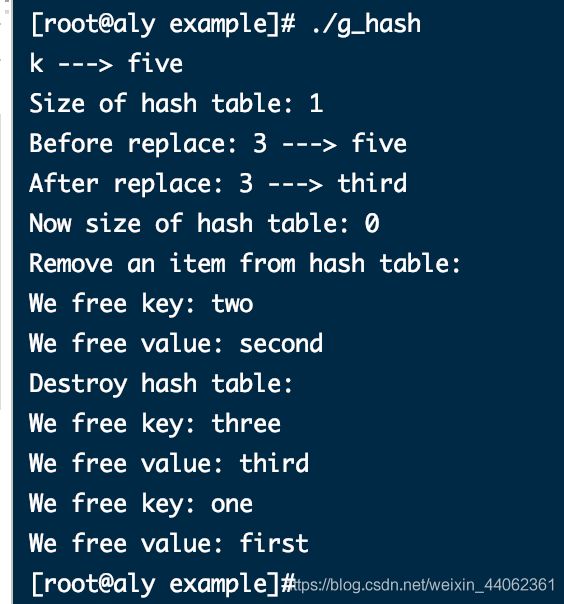Linux glib库hash表GHashTable介绍
GHashTable
- 1 简单使用
- 2 原理分析
- 3 思考总结
1 简单使用
hash表是一种提供key-value访问的数据结构,通过指定的key值可以快速的访问到与它相关联的value值。hash表的一种典型用法就是字典,通过单词的首字母能够快速的找到单词。
要使用一个hash表首先必须创建它,glib库里有两个函数可以用于创建hash表,分别是g_hash_table_new()和g_hash_table_new_full(),它们的原型如下:
GHashTable *g_hash_table_new(GHashFunc hash_func, GEqualFunc key_equal_func);
GHashTable* g_hash_table_new_full(GHashFunc hash_func,
GEqualFunc key_equal_func,
GDestroyNotify key_destroy_func,
GDestroyNotify value_destroy_func);
其中hash_func是一个函数,它为key创建一个hash值;key_equal_func用于比较两个key是否相等;
key_destroy_func当你从hash表里删除、销毁一个条目时,glib库会自动调用它释放key所占用的内存空间,这对于key是动态分配内存的hash表来说非常有用;
value_destroy_func的作用与key_destroy_func相似,
只是它释放的是value占用的内存空间。
下面以一段代码来演示glib库中hash表的基本用法:
/***************************************************************************
file: g_hash.c
desc: 这个文件用于演示glib库中hash表的用法
compile: gcc -o g_hash g_hash.c `pkg-config --cflags --libs glib-2.0`
***************************************************************************/
#include 输出如图:
2 原理分析
GLIBC中HASH表处理冲突的方式是哈希算法的“开放定址”法。
我们先来看一下GHashTable的结构:
struct _GHashTable
{
gint size;
gint mod;
guint mask;
gint nnodes;
gint noccupied; /* nnodes + tombstones */
gpointer *keys; //用于存放每一个key
guint *hashes; //用于存放每一个key所对映的hash值
gpointer *values; //用于存放每一个key所对映的value
//如果有一个key = 'age',经过计算得到这个key的hash值为431,并且这个key对映的值为22,则这三个数据分别存放在上面三个数组里
GHashFunc hash_func;
GEqualFunc key_equal_func;
gint ref_count;
#ifndef G_DISABLE_ASSERT
/*
* Tracks the structure of the hash table, not its contents: is only
* incremented when a node is added or removed (is not incremented
* when the key or data of a node is modified).
*/
int version;
#endif
GDestroyNotify key_destroy_func;
GDestroyNotify value_destroy_func;
};
看一下hashtable这个数据结构中值得关注的成员:
size:hashtable的大小,即三个数组的大小,这个大小会随着数据的添加而不断变化。初始值为8
mod:hashtable的被除数,glib使用除法散列法来避免冲突。
mask:size - 1
nnodes:总有多少对(key,value)
在调用g_hash_table_new[_full]函数时,hashtable的各个成员被初始化,这个可以查看源代码:
GHashTable*
g_hash_table_new_full (GHashFunc hash_func,
GEqualFunc key_equal_func,
GDestroyNotify key_destroy_func,
GDestroyNotify value_destroy_func)
{
GHashTable *hash_table;
hash_table = g_slice_new (GHashTable);
g_hash_table_set_shift (hash_table, HASH_TABLE_MIN_SHIFT); //将size设为8
hash_table->nnodes = 0;
hash_table->noccupied = 0;
hash_table->hash_func = hash_func ? hash_func : g_direct_hash;
hash_table->key_equal_func = key_equal_func;
hash_table->ref_count = 1;
#ifndef G_DISABLE_ASSERT
hash_table->version = 0;
#endif
hash_table->key_destroy_func = key_destroy_func;
hash_table->value_destroy_func = value_destroy_func;
hash_table->keys = g_new0 (gpointer, hash_table->size);
hash_table->values = hash_table->keys;
hash_table->hashes = g_new0 (guint, hash_table->size);//初始化三个函数
return hash_table;
}
在调用g_hash_table_insert时,我们可以看出来glib是如何实现hashtable的。我们先来看看glib是如何实现插入的。
static void
g_hash_table_insert_internal (GHashTable *hash_table,
gpointer key,
gpointer value,
gboolean keep_new_key)
{
guint key_hash;
guint node_index;
g_return_if_fail (hash_table != NULL);
node_index = g_hash_table_lookup_node (hash_table, key, &key_hash);
g_hash_table_insert_node (hash_table, node_index, key_hash, key, value, keep_new_key, FALSE);
}
上面的代码实现了插入操作,g_hash_table_lookup_node函数接受一个key变量,他会返回这个key相对映的下标,利用这个下标node_index,可以方便的得到这个key对映的value和hash——values[node_index]和hashs[node_index]。如果这是个新的key,那函数就会返回一个现在并没有被使用的下标。然后g_hash_table_insert_node就会将这个hash对(key, value)插入hash表中。
glib实现插入时会对原有的key进行检查,判断这个key是否已经存在了,如果已经存在就更改这个key对映的value,如果没有的话就添加key,hash,value。现在我们可以来看看glib是如何实现g_hash_table_lookup_node函数的。
hash表尽管使用了各种方法做hash函数,但是冲撞总是不可避免的。当我们使用除法散列时,每一个hash值对映的下标为hash%mod,如果一个key的hash值为10,另一个key的hash值为17,而被除数为7的话,这两个key就会发生冲撞。假设10已经插到下标为3(10%7)的数组里了,这时要插入17,我们只能向下查找,如果4的位置是空的,我们就可以插入到4当中了。如此循环,我们一定能找一个空的位置。但是,如果4这个位置已经被11占用后又释放了,我们需要一个标志,即使是释放了,也不能直接设为空,这个标志就是tombstone。
g_hash_table_lookup_node (GHashTable *hash_table,
gconstpointer key,
guint *hash_return)
{
guint node_index;
guint node_hash;
guint hash_value;
guint first_tombstone = 0;
gboolean have_tombstone = FALSE;
guint step = 0;
hash_value = hash_table->hash_func (key);
if (G_UNLIKELY (!HASH_IS_REAL (hash_value)))
hash_value = 2;
*hash_return = hash_value;
node_index = hash_value % hash_table->mod; //得到这个hash值对映的下标,比如10%7 =3,则这个下标为3
node_hash = hash_table->hashes[node_index]; //取出下标为3的hashs数组中的值,判断他是否被占用了
while (!HASH_IS_UNUSED (node_hash)) //当node_hash不等于0时,进入循环
{
/* We first check if our full hash values
* are equal so we can avoid calling the full-blown
* key equality function in most cases.
*/
if (node_hash == hash_value) //当hash值相等时,判断key是否相等,如果相等则返回下标值。
{
gpointer node_key = hash_table->keys[node_index];
if (hash_table->key_equal_func)
{
if (hash_table->key_equal_func (node_key, key))
return node_index;
}
else if (node_key == key)
{
return node_index;
}
}
else if (HASH_IS_TOMBSTONE (node_hash) && !have_tombstone) //当hash值不相等是,判断是否为tombstone
{
first_tombstone = node_index;
have_tombstone = TRUE;
}
step++;
node_index += step;
node_index &= hash_table->mask;
node_hash = hash_table->hashes[node_index];
}
if (have_tombstone)
return first_tombstone;
return node_index;
}
当找到给定的key时,函数返回下标值,如果没有的话,就返回tombstone的位置或者第一个空的位置。
现在我们得到了一个下标值了,我们可以将值插入到hash表中了
static void
g_hash_table_insert_node (GHashTable *hash_table,
guint node_index,
guint key_hash,
gpointer key,
gpointer value,
gboolean keep_new_key,
gboolean reusing_key)
{
guint old_hash;
gpointer old_key;
gpointer old_value;
if (G_UNLIKELY (hash_table->keys == hash_table->values && key != value))
hash_table->values = g_memdup (hash_table->keys, sizeof (gpointer) * hash_table->size);
old_hash = hash_table->hashes[node_index];
old_key = hash_table->keys[node_index];
old_value = hash_table->values[node_index];
if (HASH_IS_REAL (old_hash)) //原hash表中已经被占用了,说明给定的key已经存在在hash表中了
{
if (keep_new_key)
hash_table->keys[node_index] = key;
hash_table->values[node_index] = value;
}
else
{
hash_table->keys[node_index] = key;
hash_table->values[node_index] = value;
hash_table->hashes[node_index] = key_hash;
hash_table->nnodes++;
if (HASH_IS_UNUSED (old_hash))
{
/* We replaced an empty node, and not a tombstone */
hash_table->noccupied++;
g_hash_table_maybe_resize (hash_table);
}
#ifndef G_DISABLE_ASSERT
hash_table->version++;
#endif
}
if (HASH_IS_REAL (old_hash))
{
if (hash_table->key_destroy_func && !reusing_key)
hash_table->key_destroy_func (keep_new_key ? old_key : key);
if (hash_table->value_destroy_func)
hash_table->value_destroy_func (old_value);
}
}
上面的代码比较容易理解,就是先判断key是否已经存在了,如果存在就替换到他所对映的value。如果不存在就添加这对(key,value)。再判断是否需要调整hash表的大小。
3 思考总结
如果诸位兄台想了解glibc中HASH详细介绍的还是看Bean_lee兄的相关介绍,http://blog.chinaunix.net/uid-24774106-id-3605760.html分析得相当到位!
对API感兴趣的可以去此处https://developer.gnome.org/glib/unstable/glib-Hash-Tables.html#g-hash-table-unref,
对源码看兴趣的可以去此处http://ftp.gnome.org/pub/GNOME/sources/glib/
